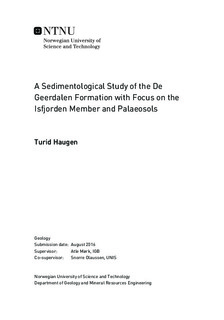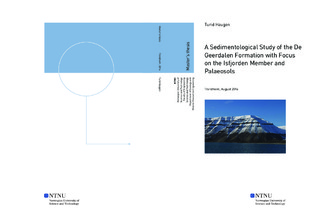| dc.description.abstract | In this study sedimentological depositional environments of the Upper Triassic De Geerdalen Formation in Svalbard have been investigated. Facies and facies associations of the formation are presented, however the main focus has been on delta top sediments and in particular palaeosols. Special attention has been paid to the Isfjorden Member, which constitutes the uppermost part of the De Geerdalen Formation. The purpose of the study has been to identify palaeosols, and relate them to the overall depositional environments. The palaeosols have been identified by three main characteristics: roots, soil horizons and soil structure. Based on field observations an attempt to classify the palaeosols has been made.
There are notable differences between brown and yellow palaeosols found in the middle and upper parts of the De Geerdalen Formation and the red and green palaeosols restricted to the Isfjorden Member. The yellow and brown palaeosols are in general immature compared to the green and red palaeosols of the Isfjorden Member. Thin sections from the Isfjorden Member on Deltaneset show excellent examples of calcrete, with clear biogenetic indicators. Distinct and alternating green and red colours might be related to fluctuations in groundwater level and reduction and oxidation of the soil profile. The palaeosols are found on floodplains, interdistributary areas and on top of proximal shoreface deposits. The number, thickness and maturity of palaeosols tend to increase upwards in the De Geerdalen Formation.
The Isfjorden Member is present on Wilhelmøya, Hahnfjella, Hellwaldfjellet, Teistberget, Klement evfjellet, Friedrichfjellet, Schmidtberget and Deltaneset. The Isfjorden Member is not present at Krefftberget, Blanknuten and Muen, probably due to erosion of the upper part of the De Geerdalen Formation. The Isfjorden Member is easily recognized by coquina beds and alternating red and green mudrocks, but the lower base of the member is not clearly defined.
Field-data were collected in 2014 (5th -23th of August) and 2015 (2nd of August to 6th of September). In this thesis mainly data from 2015 is presented. The localities visited are situated on Edgeøya, Barentsøya, Wilhelmøya, Agardhdalen, and west Spitsbergen. Contemporary field work was conducted in order to collect the data. In addition XRD and thin section analyses have been performed on selected samples.
Collected data is compared with previous studies. | |

